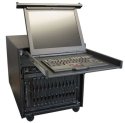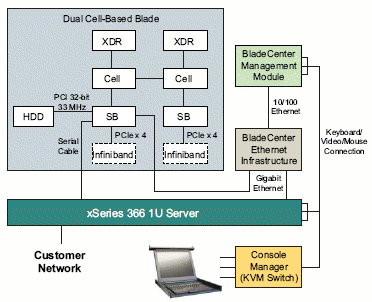First Cell-powered computer ships
Jan 10, 2006 — by LinuxDevices Staff — from the LinuxDevices Archive — 7 views The first product based on IBM/Toshiba/Sony's Cell processor has shipped, reports Mercury Computer Systems. Mercury's Cell Technology Evaluation System (CTES) is a 470-pound behemoth with one or two dual-Cell blades running Linux. It targets defense, medical, and industrial inspection markets.
The first product based on IBM/Toshiba/Sony's Cell processor has shipped, reports Mercury Computer Systems. Mercury's Cell Technology Evaluation System (CTES) is a 470-pound behemoth with one or two dual-Cell blades running Linux. It targets defense, medical, and industrial inspection markets.
 |
(Click to enlarge) |
The CTES system is available with one or two of Mercury's Dual Cell-based Blade units. Each Blade features two Cell processors clocked at 2.4GHz, and running Linux in SMP (symmetric multi-processing) mode. Each Blade also has 512MB of “XDR” SDRAM, a 40GB hard drive, and dual gigabit Ethernet interfaces (dual PCIe Infiniband HCA add-in cards will be available in Q2). The Blades run a net-bootable Yellow Dog Linux variant called “Y-HPC” that was developed by Terra Soft Solutions, one of Mercury's VARs (value-added resellers).

Mercury's CTES is based on a 19-inch chassis, and weighs 470 pounds
(Click to enlarge)
The CTES system is housed in a 19-inch, 11U IBM Blade-Server chassis with a Web-based management module, dual gigabit Ethernet switches, and an “acoustic attenuation module.” Additional components include a 17-inch flat-panel display with integrated keyboard and touchpad, 2000-Watt power supply, and an Intel Xeon-powered IBM xSeries 336 PC Server development and simulation system (a dual-PowerPC alternative will also be available) running RedHat Fedora Core 4 Linux. The system measures 34.4 x 20.5 x 24 inches, and weighs 470 pounds.

CTES architecture diagram
On the software side, an included IBM SDK offers compilers and gdb's (GNU debuggers) for the Cell processor's PPE (Power processor elements) and SPE (synergistic processor elements), along with a Cell simulator, and PPE and SPE libraries that support 32-bit PPE applications.
CTES additionally integrates a variety of Eclipse-integrated Mercury middleware, including its MultiCore Framework (MCF), aimed at managing the distribution of data across multiple computing elements working in tandem; its Scientific Algorithm Library (SAL); its Parallel Acceleration System (PAS); and its Trace Analysis Tool and Library (TATL).
Randy Dean, Mercury's VP of business and technology development, stated, “Our customers have expressed high expectations with the implementation of the Cell Technology into their application development.”
Availability
The CTES is available now to “early access” customers at an undisclosed price. Additional details can be found here.
This article was originally published on LinuxDevices.com and has been donated to the open source community by QuinStreet Inc. Please visit LinuxToday.com for up-to-date news and articles about Linux and open source.